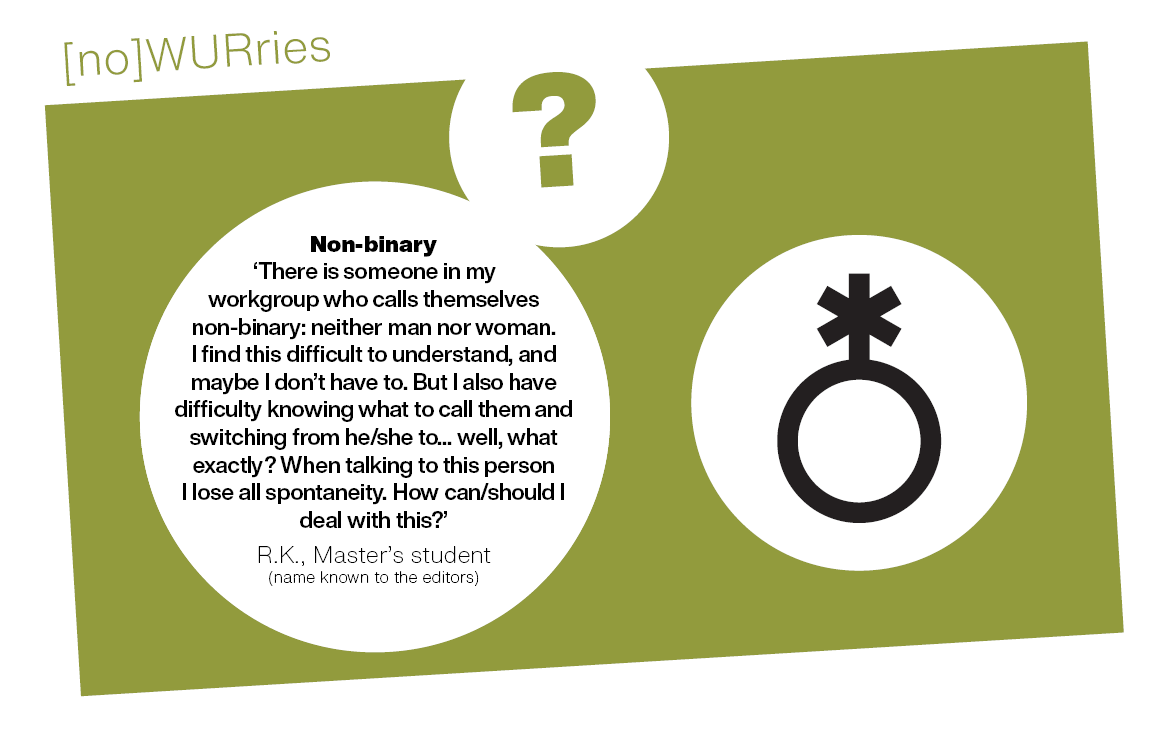Practise
‘Thank you for asking this question. Personally, I always find that new forms of address take a bit of getting used to, even though I am non-binary myself. You can ask non-binary people which forms of address you can use; it is not rude to do so. Then you can practise that form out loud when the person is not around, perhaps in conversation with others or alone in your room. That will help you familiarize yourself with new forms of address. Remember that it is normal to find it hard to switch and as long as you do your best to adapt to the person you are addressing, you are not doing anything wrong.’
Chris, former student
Just people
‘Non-binary people are just people. You can ask your group member how they prefer to be addressed. That may take some getting used to, but I’m sure your fellow student will understand that the adjustment takes some time. And as for understanding a non-binary person’s perspective … Well, I don’t always understand my “binary” colleagues either!’
Coretta Jongeling, Resource online coordinator
Examine yourself*
‘It is not uncommon to get confused when you cannot identify a person with a specific gender. That is because gender is central to our identity. We learned to identify people as men or women right from birth and in our everyday life and mainstream media you nearly always see binary forms of gender. When something so crucial gets blurred, it is a great opportunity to transform the structure that we have learned to experience as natural. Ask yourself: Why am I troubled by this? Why is binary gender reassuring? What are the negative consequences of the gender binary? This will help you get to know yourself better and put you more at ease when you talk to your course mate. It will also help to allow diverse gender expressions to emerge and get accepted.’
Chizu Sato, lecturer and researcher in Gender Studies
Heart-to-heart*
‘Have you had an open, honest conversation with this person, a real heart-to-heart? It is my experience that the main requirement for inclusion is not understanding so much as sincerity and empathy. Empathizing with the transformation process this person is going through will lead to more dialogue, more engagement and therefore more spontaneity. To start the conversation, you could simply walk up and say: “Hi, I don’t want to cause you stress or exclude you, so I’ve been wondering how you prefer to be addressed?”’
Percy Cicilia Jr, Diversity & Inclusion Officer and DARE Project Leader
Ask politely*
‘Good to hear you want to know what this person’s pronouns are. It shows that you respect their gender identity. If you are not sure how to address this person, you can ask, as long as you do so politely. For example: “What pronouns would you like me to use for you? I want to make sure I get it right.” You can still be spontaneous. You do not usually use pronouns when you talk to the person directly, only when you refer to the person. If you do make a mistake, apologize and correct yourself.’
Heather ten Ham, Diversity & Inclusion Officer for Students
Name*
Voornaamwoorden zijn persoonlijk, net zoals iemands naam. Ongeacht of iemand non-binair, man of vrouw is. ‘Pronouns are personal, like a name, whether a person is non-binary, a woman or a man. A person’s appearance does not always equate with a certain set of pronouns. If you are unsure what to call someone, you can always ask. If you use the wrong pronouns by accident, just correct yourself with the right pronoun and move on. There is no need to apologize, they will not be offended. After all, it shows your good intentions.’
Dani, on behalf of the SHOUT chat group
Next [WUR]ry:

Do you have advice for this Wurrier? Or could you use some good advice yourself? Email your tips or question (100 words max) by 18 February to resource@wur.nl, subject noWURries.

 ‘I have difficulty knowing what to call them and staying spontaneous.’
‘I have difficulty knowing what to call them and staying spontaneous.’ 

